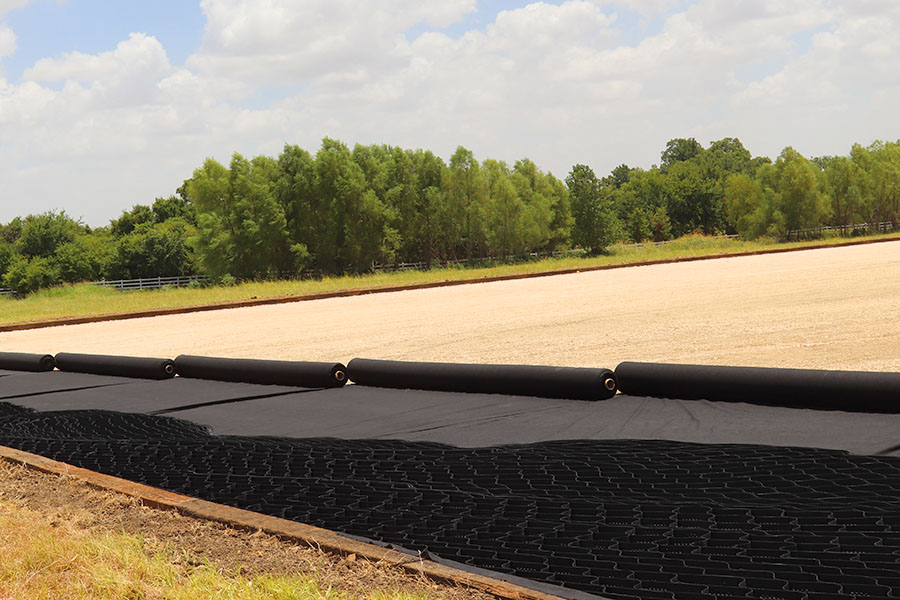It is important to have proper footing in arenas and paddocks to keep your horse healthy. Poor footing can cause injuries, inhibit the horse’s performance, and even result in serious health problems for your animal. That’s why geotextile footing is an excellent option that can benefit horses and their riders.
What are Geotextiles?
Geotextiles are a type of synthetic textile material commonly used in civil engineering and construction projects. They are composed of individual threads or filaments that are woven or needle-punched together to make a durable fabric. One of the main benefits of geotextiles is their ability to prevent water from traveling through them. That’s why they’re ideal for use in drainage and engineering projects.
Several types of geotextile membranes are available, including woven and non-woven permeable membranes and impermeable membranes. Woven geotextiles allow water to pass through while preventing fine particles from escaping. This makes them perfect for erosion control and reinforcement projects, and use in ground reinforcement and drainage systems.
Permeable geotextile membranes are typically used in applications where water flow is important, such as in retaining walls or drainage systems. They are made with the high tensile strength to ensure that they can withstand heavy loads and prevent soil erosion.
In contrast, impermeable geotextile membranes are designed to prevent water from passing through. They are often used in applications where preventing water penetration is critical, such as in landfills or other containment areas.
How Geotextile Footing Improves Health and Performance
Geotextile is a woven or non-woven fabric made from synthetic fibers. It is placed under arena footing to provide better grip, cushioning, and stability. There are several types of geotextiles available with unique advantages.
Protects Your Horse
One of the best benefits geotextiles provide is better stability for horses. Horses need a secure, stable surface so they can perform their best. Geotextiles help smooth unevenness in the footing to protect against tripping or sliding.
This is especially important to use if horses are doing complex movements in their performance that require tight control and balance.
Superior Stability, Cushion, Rebound, and Grip
Geotextiles also provide good “bounce” or rebound for horses. This comes in handy when horses must push off the floor quickly and gracefully in disciplines like dressage or show jumping. Geotextiles help them perform at optimal levels.
Geotextile footing allows horses to have a better grip on the arena floor. In disciplines like cutting or reining, horses must make sudden turns and come to a stop quickly. Geotextiles help prevent the horse’s feet from sliding—which is dangerous for the horses and their riders.
Retains Moisture and Reduces Dust
Geotextiles also help the arena retain moisture. This is especially helpful in dry climates that are prone to arid, dusty conditions. Because the geotextiles retain moisture, it can reduce harmful dust levels, sparing the horse and the rider. It can also reduce the amount of water and maintenance the horse requires.
Installation Instructions for Riding Arena and Paddock Footing
We know that geotextiles are beneficial and cost-effective options for a horse arena. So, how do you properly install geotextiles in the arena or paddock? Luckily, the process is fairly straightforward and simple. With some planning and preparation, you can safely install geotextiles.
- Remove the old footing. Before you install geotextile, remove any old footing or paddock in the arena. You can use a tractor, skid steer, or do it by hand
- Prepare the floor. After you remove the old footing, grade and level the arena’s surface to achieve a smooth surface. You may need to use a laser level or grading blade.
- Include silica sand. Add a layer of silica sand a spread it evenly over the arena’s surface. This will provide a secure foundation for the geotextile.
- Lay the geotextile. Next, lay the geotextile on top of the silica sand. Let the edges overlap several inches so there is a seamless surface. Cut the geotextile to fit the arena or paddock’s shape and secure the edges with stakes.
- Include footing material. Once the getextile is laid, add sand or rubber on top as footing material. How much footing material you need will depend on the horse’s needs and disciplines, as well as the arena or paddock’s layout.
- Level the footing. Compact and level the footing material so the surface is smooth and consistent. You may need ot use a drag or roller. Repeat this process periodically to maintain the footing.
How to Properly Maintain Arena Footing
Proper maintenance of your arena’s footing is necessary to ensure a safe surface for horses and riders. With proper maintenance, uneven footing, water accumulation, and other problems that can affect your horse’s health and performance can be avoided.
Daily Arena Dragging and Leveling
It is important to drag and level your arena footing regularly. This will properly redistribute the footing material so that it doesn’t become too impacted. It will also keep water from accumulating in uneven spots, protecting the horses and riders from unsafe surface conditions.
Get Started
Properly maintaining your area footing is necessary for keeping a safe environment for your horse and its performances. Regularly drag and level the footing and consider using geotextiles to provide an excellent riding and performing surface. A wide range of geotextiles are available so you can find the right option for your arena or paddock.
